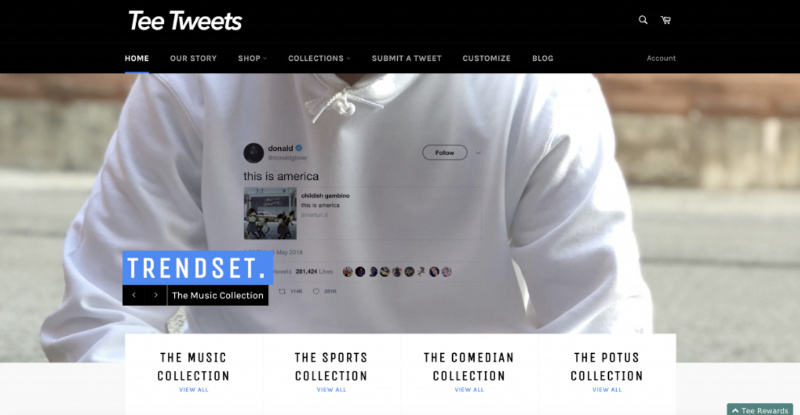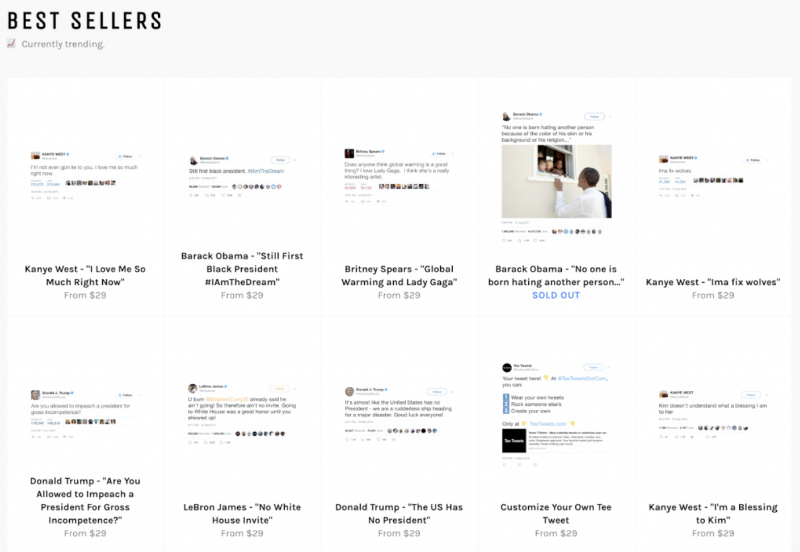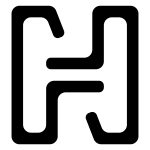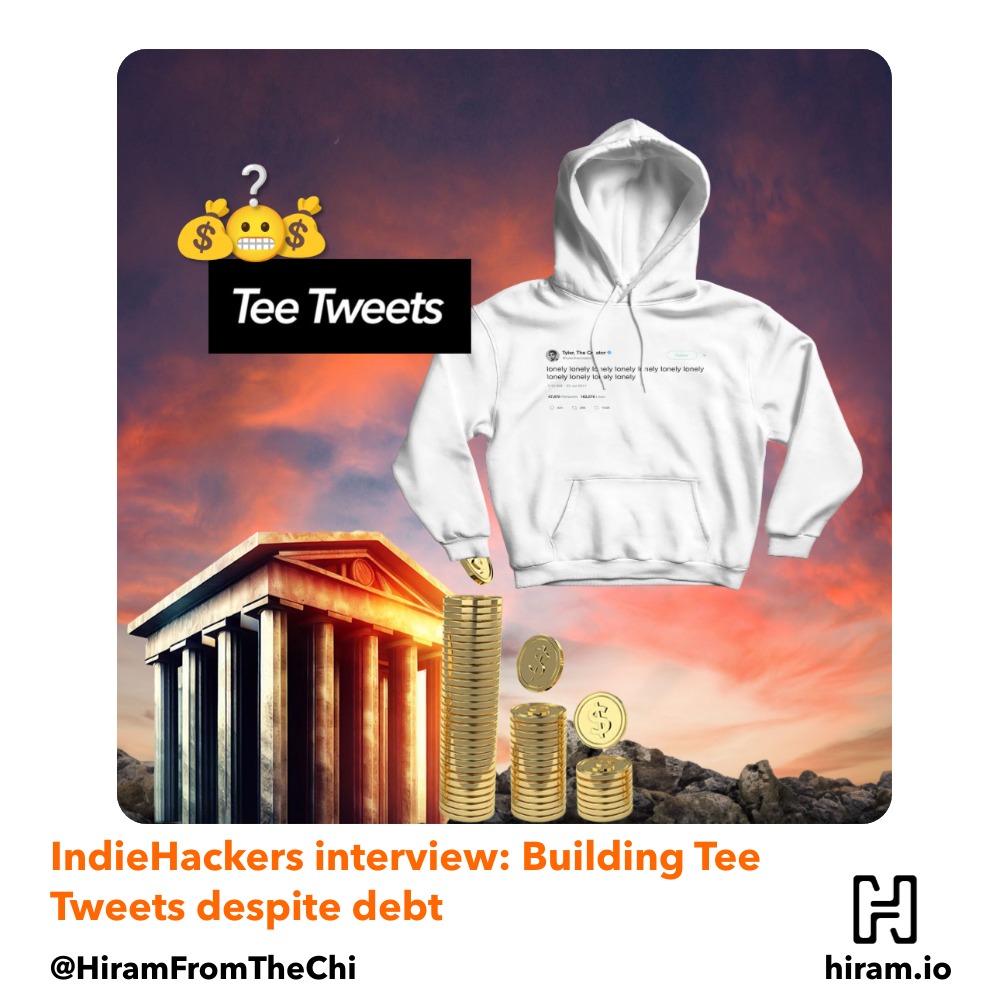Table of Contents
Hello! What’s your background, and what are you working on?
What motivated you to get started with Tee Tweets?
What went into building the initial product?
How have you attracted users and grown Tee Tweets?
What’s your business model, and how have you grown your revenue?
What are your goals for the future?
Have you found anything particularly helpful or advantageous?
What’s your advice for indie hackers who are just starting out?
This post is an article that originally appeared on IndieHackers when I did an interview with them surrounding Tee Tweets and how I built it.
Hello! What’s your background, and what are you working on?
Hey there, my name is Hiram and I am the founder of Tee Tweets. Tee Tweets is a clothing brand that allows you to wear any tweet in the world. Most are celebrity tweets, but we also offer the ability to customize your own tweet-meaning you can wear your own tweets, the tweets of friends and family, or have a “fake” tweet designed entirely from scratch to create your own spin.
One of my favorite (and trickiest) parts of Tee Tweets is the wide audience net that it casts. Due to the nature of tweets and subcultures on Twitter, there are many different audiences live on Tee Tweets at any one point. For example, we get a lot of Kanye West fans buying Kanye tweet shirts. At the same time, we also get a lot of people who do not like Kanye, but like wearing his outlandish tweets sarcastically or to prove a point. A similar instance happens with The POTUS Collection. In a sense, the tweet is not the message, the wearer is.
It makes sense from every angle and with every single tweet that exists, so in some ways, it’s an easy sell. This wide audience with varied wants and needs makes it extremely difficult to do targeted marketing but does present a great opportunity to do generalized marketing.
Tee Tweets currently does about $1,200/mo in revenues and has great organic reach in searches.

What motivated you to get started with Tee Tweets?
I came up with the idea for Tee Tweets in early February of 2017. The US presidential inauguration had just occurred, and it seemed all anyone could talk about was Donald Trump’s tweets. And it wasn’t only him-celebrities became more vocal on Twitter in response. Everyone was focused on Twitter, and I just knew there had to be some sort of play there.
The idea of Tee Tweets came during the last semester of my time at IU, so the timing was also appetizing. Despite having to do my thesis, as well as some freelance consulting as soon as I graduated, I figured there would never be a better time. And so, Tee Tweets was born.
“You have to be willing to jump off the cliff and try to build an airplane on the way down.” — Hiram Núñez
Taking the leap was scary. I had actually contemplated dropping out after freshman year and starting a business, but I had lots of pressure to finish college, get a good job, etc. You know, the “traditional” family advice. My anxiety only grew as the launch approached. As a broke college student with student loans due soon, I knew it was a huge risk with potentially devastating consequences for failure. I think this is something every entrepreneur struggles with when contemplating taking that first big leap.
(Side note: I don’t particularly like calling myself an entrepreneur — I think it’s a loaded word that gets tossed around a little too casually these days.)
After lots of thought, I decided to make my first purchase order as a way of “locking” myself in and fully committing to the business. The initial $800 purchase order was an enormous amount of money for me, especially at the time, with no failsafe whatsoever, so it was my way of doing less thinking and more doing.
I had no prior background with in, let alone eCommerce. I had, however, worked with a startup out of San Francisco called Gametime for two years in marketing and growth. I was extremely low on the totem pole, but it was a great experience nonetheless. I got to know some guerilla marketing strategies, managed some social media accounts, and dealt with Mixpanel analytics. As a brand ambassador, I was also on the ground working sports venues and bars, so there was a lot of interaction with potential customers.
These interactions were invaluable for learning how to speak with prospective customers, and how to move past being ignored or rejected. Sounds rough, but it’s better to learn sooner than later. I had also done freelance photography and a financial internship where I applied my Excel/accounting skills, which proved useful down the line.
What went into building the initial product?
Time is the most valuable asset anyone has, especially when building a business. During the summer of 2017 when Tee Tweets launched, I was juggling three different ventures:
- Programming and implementing a database from scratch for a real estate company (which would determine if actually graduated or not)
- SEO consulting (a role that would later evolve into a one-man show of marketing, cybersecurity, video editing, and content creation)
- Tee Tweets top to bottom
Like many founders, I had endless late nights, especially during the summer. I was regularly going to bed around 4 AM. A lot of tasks could have been outsourced… if I’d had the money! In lieu of money, I did what most people do and learned how to do everything myself.
From creating mockups in Photoshop to finding models, doing product photography, title tags, meta descriptions, product descriptions, logo design, accounting software, customer service, sales channels-you name it, I did it. In addition to having to self-educate, the project was also self-funded, so everything had to be done in the leanest way possible.

How have you attracted users and grown Tee Tweets?
It wasn’t until much later that I learned how important it is to have press around your launch. Because of this hole in marketing, the biggest piece of media we had around the launch was one Instagram post with just a few likes signaling the store was officially open. As you can imagine, there was not a lot of fanfare.
A lot of emphasis was put into SEO. Unfortunately, SEO results typically don’t begin to kick in until six months later, at least. So, I tried a few other free marketing tactics.
One tactic was doing a “shop ad exchange”. This is where you advertise someone else’s store in exchange for your advertisement on their store. This didn’t last long, however, as it didn’t fit with the Tee Tweets theme and it looked bad on our website. You also hardly ever see a store advertising for another store, so it just didn’t work. That idea was scrapped pretty quickly.
“We live in the age of keyboard warriors and Twitter fingers. Don’t let that discourage you. Listen to the market, but block out the noise.”
The other free tactic I had was getting involved in the Reddit community. There are a handful of clothing and shirt subs, so we would post some shirts on there to try to get some traction. It worked fairly well, though it’s tough to stay updated within those subs. It’s also very important that you post within the rules of each sub, so it can get tricky cross-posting or accidentally breaking a rule because you think you’re in one subreddit when you’re actually in another.
Instagram is a great place to showcase your items. It is, however, extremely saturated, so organic reach is tough. With the ever-changing algorithm, it takes a lot of trial-and-error testing in order to find out what Instagram deems worthy enough to show to your fans or prospective fans. Like SEO, this is a never-ending practice.
Twitter was a no-brainer, given that the business is based around tweets. There is, however, a lot of noise on Twitter. This is where community management can do wonders for you if done right because it has the potential to go viral. It’s near impossible to end up on the Explore tab on Instagram. There are a lot of elements that go into virality on Instagram, such as engagement, number of comments, how quickly you received that engagement, your past Instagram practices, and many more elements that only Instagram employees know. On Twitter, however, a few retweets will get you rolling and get people engaged. This is something that is unique to Twitter and can really boost your visibility.
The huge downside to social media is that you’re building an audience on someone else’s platform. It’s often advised that you build up your own email list in tandem with or in addition to any social media following you have going. Social platforms are changing all the time, in ways that you can’t necessarily predict or control. So it is good to have your own way to talk to your customers and community.
One major piece of advice: Be authentic. People are smart, they can make their own decisions. And your product will not be for everyone. Even with the wide net that Tee Tweets casts in terms of audience, there are many people that remain critical. That’s okay-it’ll depend on the situation in terms of how you want to handle it, but we live in the age of keyboard warriors and Twitter fingers. Don’t let that discourage you. Listen to the market, but block out the noise.
What’s your business model, and how have you grown your revenue?
Tee Tweets makes revenue through product sales online. It currently does around $1,200/month, though it does fluctuate. Retail is seasonal and cyclical, so some fluctuation is natural. However, not all of our fluctuation can be explained by natural market tides. January and February were actually better months in terms of holiday season sales, which was an odd (yet good) trend for Tee Tweets. Traditionally, January is when retail companies lose a lot of money on returns. The first return actually didn’t occur until mid-2018, a year after inception.
Sales fluctuations happen for a couple of reasons. The first is SEO. Whenever there are changes to alt tags, meta descriptions, or missing pages, you need to reindex your site. As it’s being reindexed, you’ll notice some dips in traffic while the search engines determine the changes you’ve made and place your site based on their algorithms. If your products are constantly changing or you add new ones quite frequently, this will happen from time to time, depending on the situation.
The season also matters. With Tee Tweets, it’s a bit less cyclical because shirts are year-round items, and even when it’s not hot enough to wear a tee on its own, Tee Tweets provides crewneck sweaters and hoodies so you can wear your tweets proudly year-round.

What are your goals for the future?
One of the main things I’d like to keep ramping up is product development. I’m hoping to release a line of tank tops soon, but it’s incredibly time-consuming to mockup all existing tweets for a new product.
Additionally, it means that when new tweets are released, there will have to be eight total image variations (black and white garment images for shirts, sweatshirts, hoodies, and tanks).
I believe this will help reach an even broader demographic, given some of our tees have been turned into fashionable crop tops as well. The possibilities are practically endless in terms of product development.
The biggest roadblock is doing everything myself. With no help, Tee Tweets can’t scale. So my next steps are focused on outsourcing where possible in order to scale.
What are the biggest challenges you’ve faced and obstacles you’ve overcome? If you had to start over, what would you do differently?
The number one thing I was blindsided by was the sheer amount of time it would take to actually build and run a business. You’re probably thinking, “It’s just a t-shirt company, how hard could it be?” Well, I thought the same thing. Turns out: very. This is due to a number of reasons.
Supply chain
Tee Tweets is not dropshipping. Many t-shirt businesses that exist are dropshipped, with no control over the quality of the product. The major advantage of dropshipping is that time is spent on other things, like marketing, content creation, etc. However, it is much more difficult to build a lasting brand when dropshipping.
Quality
Since its inception, I was very adamant about creating a quality product that would turn heads, be comfortable, and people would wear proudly. 99% of t-shirts on the market use the lowest-cost fabrics with the cheapest printing method. Tee Tweets doesn’t. This dedication to quality cuts margins, but people are much happier with their product, which also reduces product returns, and I think we’ve seen proof of that.
Content creation
It takes a lot of time and energy to create quality content. At the same time, quality can be subjective, so I’m sure some of the stress in content creation has to do with what and how you determine “quality” when it comes to your own work. The content creation business is booming right now, but such a high turnout from so many different sources often comes at the price of quality.

Manufacturing
All items are printed in-house, so it’s very tricky making sure that the items are “perfect.” Especially in a house with two dogs who refuse to quit shedding, even in the winter. I have a section of my apartment closed off to make sure there is a little dust and movement there as possible. My goal is to control the environment around manufacturing. Think Breaking Bad, except I’m not making millions off of a single production run.
Marketing
As I mentioned earlier, marketing is particularly tricky with tweets because Tee Tweets’ audience varies so much. There are people who love Kanye, people who hate Kanye, people who love politics, people who hate politics, others who passionately hate Kevin Durant, and others who don’t care about sports. Tailoring content and marketing to these different audiences is especially agonizing because people formulate impressions about your brand instantly. On the more technical side, strategic marketing matters because search engines are constantly trying to figure you out and place you in front of people who are actually looking for you (or your competitors).
Timing
Since Tee Tweets is based around a lot of pop culture, sports, politics, and more, things can go south real quick. Prime example: When Kanye aligned himself with Trump, Kanye Tee Tweets sales plummeted. However, Stephen Colbert and other comedian Tee Tweet's sales remained consistent and even spiked a little. Pop culture has an economic calendar all its own.
Have you found anything particularly helpful or advantageous?
This will sound silly, but I initially wanted to distance myself from the Tee Tweets brand itself because I’ve always wanted people to support Tee Tweets because they genuinely like the brand and believe in it, not because my friends want to support me and will buy a shirt even if they don’t like it.
Don’t get me wrong, I’m eternally grateful for the support from my friends and family, but I always wanted to feel like I earned it. I’ve recently come to the realization that there is no getting away from your company’s brand, even if you have the ability to create some distance because there are people on your team helping to run the day-to-day.
Amazon is synonymous to Jeff Bezos, Tesla is synonymous to Elon Musk, and Berkshire Hathaway is synonymous to Warren Buffet. The company’s mistake is seen as their mistake, even if they had nothing to do with it. So, there is no use in trying to escape it. It’s just the way it is. As a leader, you have to own it, learn from it, and keep pushing forward.
What’s your advice for indie hackers who are just starting out?
The number one thing I could say is to just do. Maybe it’s just me, but I tend to overthink a lot when it comes to business and I’m trying to change that. I will often get stuck in analysis paralysis, but the reality is that you won’t know until you try it out. We can go back and forth on the “what-ifs” all day long, but until action is taken, there is nothing concrete to base further decisions on. There are so many different factors that go into determining your outcomes. You have to be willing to jump off the cliff and try to build an airplane on the way down. If it fails, at least you know and can learn from it.
“If you’re waiting for the ‘perfect time’ to come along, it never will.” — Hiram Núñez
The biggest poison in the world is regret. When I think about this, it drives me to take action. If you’re waiting for the “perfect time” to come along, it never will. You just have to do it. If not now, when?
If you're an indie hacker, solo maker, or launching a business, let's connect:
- Web: hiram.io
- Rising Tide (blog): hiram.io/blog
- LinkedIn: @hiramfromthechi
- Twitter/X: @hiramfromthechi
- Medium: @hiramfromthechi
- Mastodon: @hiramfromthechi@mastodon.social

